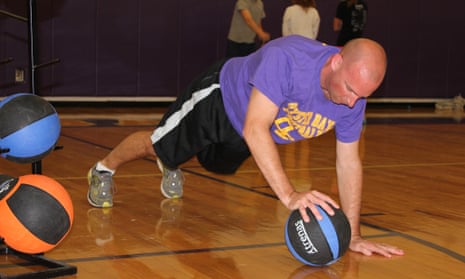Every year I set my high school students an exciting challenge that might, at first, sound unusual. I ask them to become personal trainers for their teachers.
The Train Your Teacher project, which I teach to ninth to twelfth-grade students (14 to 18-year-olds), started as an idea for an interactive performance-based assessment. Students are allocated a teacher for whom they create an exercise programme.
The project is explained in class and then teachers are invited to sign up. However, getting them involved can be tricky – I need willing participants who are free at the time my class runs. Not all teachers want to take part, some because the project is new, others feel they’re already in great shape. When they say this, I ask them to identify any gaps in their training and we discuss how my students could help.
Teachers who volunteer must share information about themselves, including their fitness levels and whether they have any history of injury. Every volunteer has been co-operative. Teachers also need to be willing to take direction from students.
When I cannot get a teacher for every child I get students to work together. Another thing I have thought about trying is getting students to run fitness classes, such as yoga or Zumba, rather than conduct one-on-one training. But the ideal situation is to have one teacher per student.
The first lesson involves getting students to think what information they need to design a good exercise programme. They write questions, such as “do you play sport”? “In what other ways do you work out?”
Students are encouraged to ask follow-up questions based on the information they gather. When the teachers leave the classroom on the interview lesson day, there’s usually around 15 minutes to brainstorm. Groups of around three share information and then we talk as a class. I try to get students to solve problems themselves.
Over the next two or three classes we build routines. Students write down which exercises they are implementing and how they’ll teach them. They state why they’ve set these exercises and how much time should be spent on each activity.
Once the students feel that they have written a proper programme, it is submitted for review. After I’ve looked at it, students take a classmate through the programme, practicing teaching cues, timing and getting feedback.
In the final lesson, teachers come to the gym for a dynamic warm-up while student trainers make sure everything is in order. Then I step back and my class takes over. I watch as they apply their learning, and colleagues joke that they regret signing up as sweat beads roll down their face.
If you’re trying this lesson, make sure you have reliable teacher participants. They need to be reminded of the times they’ll be needed. In the past teachers have agreed to take part, shown up for the interview and then missed the workout. When this happens student assist another pair.
The class must understand the proper form and technique for each exercise. Nothing can derail the experience more quickly than an injury. They also need to realise how serious the project is and handle themselves in a mature manner.
I often get asked, “Why do I need to do this, Sir?”. It’s not just up to a teacher to explain the relevance of classroom learning. When young people reflect personally and talk through ideas with peers they get more from their studies. This allows students to do something practical with their learning.
The project takes place at the end of a fitness unit focusing on different concepts such as muscle fibres. In addition, students learn about different pieces of equipment such as battle ropes, slide boards, medicine balls and kettle bells.
At the end of the process there is laughter, gasping for air and gluggling of water. I can hear my students telling their teacher volunteers why this program fits their goals and why fitness is relevant to their life.
This project is typically used as a summative assessment at the end of a unit, but there have been talks about continuing the training and routine development. Teachers would return to the students once a month for testing to track progress over the school year. Students would then alter routines as needed.
If you introduce this programme, make sure you show what you’ve done. Take pictures and videos and ask the school paper to do a report.
Charles Rizzuto is physical education (PE) teacher at Oyster Bay high school in New York, US. Follow Charles on Twitter: @RizzutoEd

Comments (…)
Sign in or create your Guardian account to join the discussion